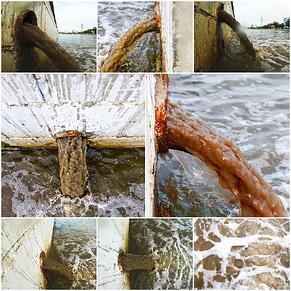Throughout my entire life I have always had an appreciation for water. Growing up in the Midwest, I spent my summers at the lake and winters in the snow. As a child, school taught me that water makes up ~70% of the earth’s surface and that most of that water is oceanic water (aka-salt water).
I also remember learning that most species on earth (including humans) survive on fresh water and that fresh water makes up only a tiny fraction of earths water supply. In fact, water plays such an important role in our daily lives; I think it is safe to say that most of us have had to learn about the importance of preserving our fresh water supply. But what does it mean to preserve our water supply? To answer that question, you must first ask another question – What is wastewater?
So, what is wastewater?
Wastewater is a very general term, and the potential types or sources of wastewater are endless. In my career, I have had the opportunity to visit dozens of environmental laboratories that test wastewater and I have seen countless examples, such as neon-green mystery liquids, raw sewage, discharge from food plants and everything in between. So, it is difficult to pinpoint the best way to describe wastewater, but I always seem to circle back to describing it as “non-potable water” meaning water that is not safe for human consumption or other living organisms. This is the reason why the key to preserving our fresh water must first start with defining wastewater.
of wastewater are endless. In my career, I have had the opportunity to visit dozens of environmental laboratories that test wastewater and I have seen countless examples, such as neon-green mystery liquids, raw sewage, discharge from food plants and everything in between. So, it is difficult to pinpoint the best way to describe wastewater, but I always seem to circle back to describing it as “non-potable water” meaning water that is not safe for human consumption or other living organisms. This is the reason why the key to preserving our fresh water must first start with defining wastewater.
Now I know what you are thinking, “well if wastewater is bad, then just stop it at the source, boom, problem solved”. The issue with this solution is that wastewater is an inevitable part of life and if life exists, so will wastewater. If you have ever owned a fish tank, then that statement will make perfect sense. The reason being is that anyone who has ever owned a fish tank knows that maintaining it is a constant responsibility. The water must have air pumps and the water chemistry must be monitored. Even with all the proper equipment, monitoring, and chemistry adjustments there comes a point where the owner must drain the water and replace it with fresh water. This is because the water becomes unsafe for the fish to live in and is now considered wastewater.
For humanity, our wastewater situation is a bit more complex than your everyday fish tank. Think about our daily activities, every day we are sending things like toothpaste, soap, food waste, and more down the drain. It is incredible how much wastewater a single person produces in a day and is why urban areas and cities have large wastewater treatment plants (WWTP) that are in operation 24/7. In the area where I live, there are several of these WWTPs and on average, they are responsible for treating 1.3 billion gallons of wastewater every single day. I repeat, 1.3 billion gallons each day! Like the previous fish tank example, WWTPs require constant equipment maintenance as well as monitoring the wastewater coming into the plant (influent) and the treated water discharged by the plant (effluent).
Unlike the previous fish tank example, monitoring the chemistry of the influent and effluent at WWTPs is much more complex. For this reason, wastewater testing requires specialized laboratory equipment capable of detecting contaminants that are hazardous to life. In addition, most countries have standardized the analytical methods and guidelines that laboratories must follow in order meet regulatory compliance requirements and report their results. In the United States, these methods are primarily developed by the United States Environmental Protection Agency (USEPA) and most WWTP must meet the requirements set by National Pollution Discharge Elimination System (NPDES). The NPDES sets limits for contaminant discharge which WWTPs must adhere to. These limits help treatment plants detect contamination in our wastewater and monitor the plant’s ability to remove that contamination prior to discharging the treated water back into the environment. For this reason, I believe it will always be our responsibility to monitor the wastewater we produce and ensure that we are held accountable for preserving our fresh water supply to sustain the future of humankind.
If you would like to learn more about how Biotage supports wastewater testing and regulatory compliance, visit our wastewater testing webpage.
Follow below link to view our on-demand webinar on Reduced Sample Volume Extractions in Compliance with EPA Method 1664.

 Organic Workflow
Organic Workflow Peptide Workflow
Peptide Workflow Scale-Up Flash Purification
Scale-Up Flash Purification  Sample Preparation
Sample Preparation Biomolecule Purification
Biomolecule Purification Oligo synthesis
Oligo synthesis Scavengers and Reagents
Scavengers and Reagents Service & Support
Service & Support Accessories & Spare parts
Accessories & Spare parts Investors
Investors Reports & News
Reports & News The Share
The Share Corporate Governance
Corporate Governance Calendar
Calendar Sustainability
Sustainability Our Offering
Our Offering Our History
Our History Our Locations
Our Locations Leadership
Leadership
